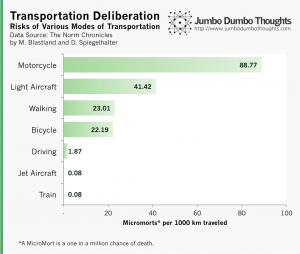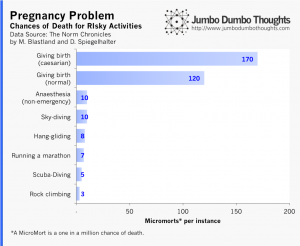Our lives can end at any moment. Even if we entertain the possibility of indefinite life by means of medical technology, we cannot escape the risk of being killed in any number of unexpected ways. Some have attempted to quantify this risk. The micromort is a concept introduced by Ronald Howard in 1980, which is supposedly equal to a one in a million chance of dying. For instance, running a marathon is supposedly worth 7.5 micromorts, as 7.5 out of every million people who run a marathon tend to die doing so. Simply “getting out of bed,” is equal to 1 micromort for an 18 year old and 436 micromorts for a 90-year-old man. The micromort may be a useful tool to gauge the risk of various behaviors and act accordingly. For instance, the knowledge that driving a car for one hour a day is worth 2 micromorts, while driving a motorcycle for 1 hour per day is worth 60 micromorts would enable one to make an informed decision to drive a car rather than a motorcycle, thus decreasing one’s risk level by 58 micromorts per hour. However, risk management in isolation only functions to sustain existence, and is not directed toward the end of “living” in any robust sense.


Taken to an extreme, this concept of maintaining existence in isolation is directly related to that of incomplete death. That is, the maintenance of one’s existence without necessarily maintaining one’s full personhood. Kaufman (2000) discusses the questionable personhood of those who exist within a comatose or “locked in” condition. For Kaufman, the selfhood of these individuals is diminished, as they are incapable of exercising “autonomy, freedom, or expressive intentionality” (77). The “locked in” or comatose individual may not be capable of expressing themselves in any way, but the forces of modern medicine still work toward reducing their risk of death, or number of micromorts, at any given moment. In this context, the forces of modern medicine practice a form of risk management fundamentalism that is solely concerned with the maintenance of existence, rather than the maintenance of life.
Risk management also ties into the concept of self-quantification, whereby one keeps track of data regarding diet, exercise, or any number of activities in pursuit of self-improvement. Though the boundaries between life and existence are more blurred within the concept of self-quantification than within that of incomplete death, one may speculate that the data collection in pursuit of improved health and productivity may require some sacrifice of emotional wellbeing. That is, it may prevent one from fully experiencing life in the present as one must perpetually enter, maintain and analyze data of one’s activities. In this way, self-quantification entails some extent life sacrifice in pursuit of the increased longevity of existence.
The concepts of incomplete death, self-quantification and risk management more broadly serve as a reminder of the distinction between life and existence. Whatever the future of life extension technology may bring, we must be wary of the potential for the use of technology to sacrifice life in pursuit of extended existence through extreme risk management.
Sources:
http://www.abc.net.au/science/articles/2015/09/29/4320028.htm
http://www.sciencealert.com/this-unit-of-measurement-figures-out-how-likely-you-are-to-die-from-certain-activities
https://utahavalanchecenter.org/blog-what-risk-riding-avalanche-terrain
https://canvas.newschool.edu/courses/1339687/files/folder/Week%206?preview=62625063
http://www.tjpalanca.com/2014/03/on-probability-of-mortality.html
Recent Comments